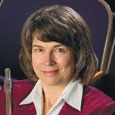It is common for flute students to change teachers, especially at the college level. This transition is exciting but it can also be frustrating and confusing. A new teacher has different expectations and may explain concepts differently than the previous teacher. Such pendulum swings are necessary and should be welcomed as a sign of progress.
For example, playing in the high register is taught differently at different levels. Beginners are often taught that the aperture has to be smaller and to blow harder, aiming the air across the flute rather than down. More advanced students frequently pinch in the upper register and are encouraged to relax the embouchure and aim the airstream down to lower the pitch. The goal is to control the high register but the techniques are diametrically opposed.
Another example of contradicting teacher styles is the quantity and quality of material covered. Beginners’ assignments are usually small in quantity; advanced high school players learn music quickly. At the college level, a new teacher may focus on such basic skills as breathing, tone, or vibrato before moving on to greater repertoire. A college student may have several weeks of playing nothing but slow movements or tone exercises. At this stage such basic work may seem like regression. This is frustrating because there is no sense of accomplishment from learning large quantities of material. The student is challenged by a change of philosophy with subtle goals instead of more repertoire. Later, the student may not want to learn a lot of music if the goal is to perfect the sound, pitch and vibrato of every note. This detail work should be incorporated into learning new material later.
When a teacher emphasizes musicality, he may stress phrasing and write crescendos and decrescendos in a student’s music, regardless of the style. Later, if the dynamics are inappropriate for balance or structure, a teacher may change those nuances. Learning to play expressively is the root of musicality, even though a teacher may change his mind.
I recently changed my approach to breathing. Keith Underwood suggested I shift the focus of my breathing from abdominal support to expansion of the rib cage. I always tried to emphasize both concepts in my teaching, but I began to focus too much on the idea of support. My air moves more freely now that I have a fresh approach to breathing.
There are many other instances of pendulum swings in any flutist’s career. The seemingly opposite advice from a new teacher builds on the advice of a previous teacher. Such pendulum swings are inevitable when switching teachers, but ultimately a student’s best teacher is himself.






